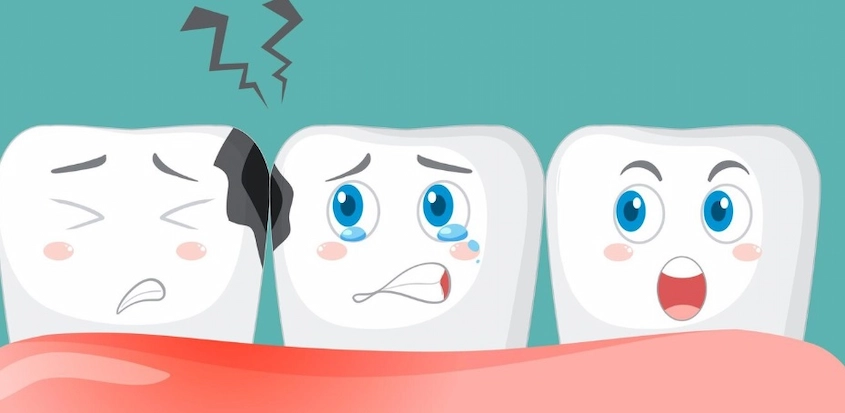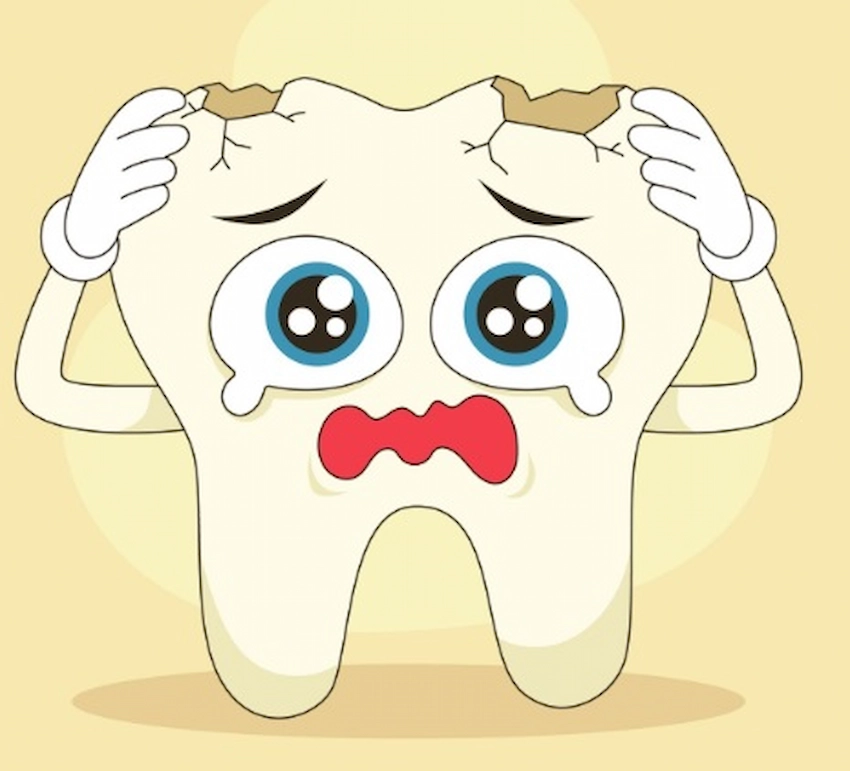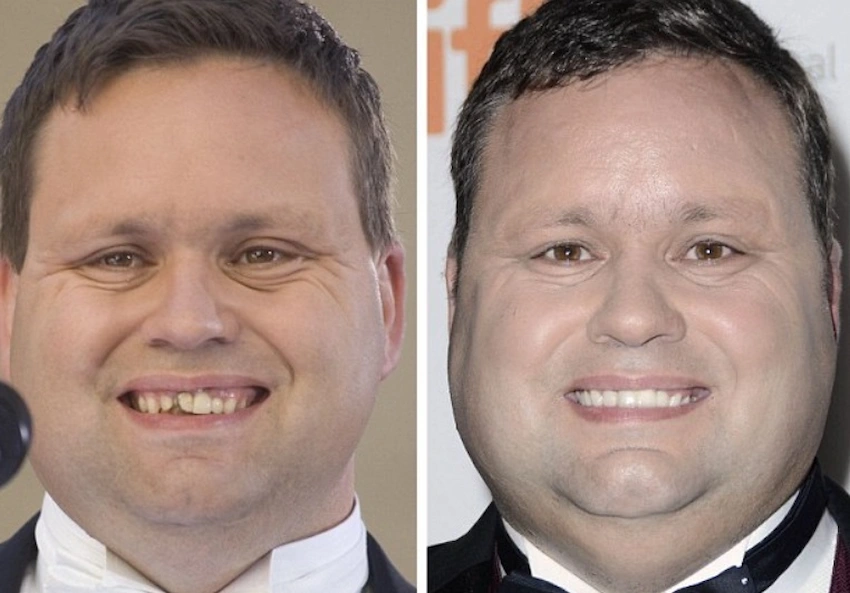🦷What is Cracked Tooth Syndrome?

Cracked Tooth Syndrome is a perplexing dental condition characterized by constant pain and discomfort in one single tooth that has unusual visible cracks. This syndrome is generally seen in teeth, which may appear normal – but are subjected to enormous and excessive stresses. The cracks may not be readily visible and may develop due to different factors, like clenching of teeth and chewing ice or other hard objects.
These cracks result in increased sensitivity, especially while consuming certain foods and drinks that may also increase pain. For this reason, prompt treatment becomes critical for maintaining the tooth health and integrity as well as to avert other chronic dental issues from developing.
Causes of Cracked Tooth Syndrome
Now, Cracked Tooth Syndrome can be caused by several factors. First and foremost, trauma or injury that occurs on the tooth is one of the leading causes. Additionally, excessive biting or grinding forces exerted on teeth can also cause cracks on the tooth over time. Other conditions such as large dental fillings or cavities can affect the interior of a tooth thereby increasing its chances of fracturing. Understanding these causes is vital enabling prevention from these cracks from occurring.
Trauma and Injury
Now Trauma and injury are significant causes of Cracked Tooth Syndrome. A sudden impact or blow to the tooth, while playing sports or after an accident can result in cracks. Such injuries might not be apparent on the exterior part of the tooth but may be serious if left untreated. These situations should, thus, be seen with importance since in some instances the tooth may appear to be in good condition but yet internal damage can come to cause pain and discomfort due to a crack that has appeared within.
Excessive Biting Forces
Excessive biting forces are another critical factor in the development of Cracked Tooth Syndrome. Constant pressure from chewing hard foods or grinding teeth physically may weaken the tooth structure thereby leading to cracks over time. This targeted condition is more likely to happen among a certain cohort, namely individuals who have a habit of clenching or grinding teeth during their sleep or day.
Therefore, by reducing these biting forces, individuals can help protect their teeth and lower the chances of experiencing cracking issues. In particular, practicing conscious relaxation techniques when one is learning or in a tense situation can benefit one’s teeth as well.
Underlying Dental Issues
There are indeed plenty of dental issues that were invisible from the outside that can potentially be detected in Cracked Tooth Syndrome. The fractures of the teeth are initiated from dental passages that are unable to be seen due to the density of their filling materials. Large fillings, make deep cavities, and the truth that the teeth are weakened, all of these factors lead to the emergence of green wood cranks in the teeth.
Such conditions not only diminish the overall tooth quotient drastically but also cause cracks easily. The characteristics of the teeth that should be focused on and to be changed, if any, will largely influence the risk of further damages. Therefore, it is significant to keep up with dental health and get the required dental treatments as soon as possible to prevent more harm. The dentist besides the regular check-ups can be the best guide to these issues related to the utmost care and preventive measures for the teeth.
Symptoms of Cracked Tooth Syndrome
Some of the common signs of Cracked Tooth include symptoms that are quite vague in nature. First, these signs might not be innately recognizable, pain that emanates from the socket for even a second; it has been observed at 1st to 2nd degree. Sudden sharp upsurge including chewing down foodstuffs or enduring hot/cold temperatures have been known causes and must be examined closely.
Due to the fact some fissures expose the actual inner parts of the teeth; it is therefore common for people to experience what is known as tooth sensitivity. Thus, it is possible for the other very little manifestations, which are of no importance, to be not noticeable except for pain and discomfort referred to above. These symptoms reveal a Cracked Tooth Syndrome that needs immediate corrective action.
Pain and Discomfort
The concurrence of pain and discomfort in people having a Cracked Tooth Syndrome-related complication may seem to be one of the indications of the problem. People usually have at one point or another taken food that appears to be very normal and seems to strike a certain point of the mouth and there is the feeling of sharp pain from the socket of the affected tooth. This excruciating feeling would at times, just like pulling out one’s extract or standing up, would pose itself if the object is released.
Sensitivity manifestations will once in a while trigger instances when cold or hot foods, drinks, and other substances being consumed during meals would make people feel uncomfortable while eating or drinking. Accepting discomfort level sometimes ranges from mild to severe, whenever consulting a dentist to attend to these problems and not doing anything will only lead to increased pain. These symptoms indicate the need to see a dentist for possible diagnosis.
Tooth Sensitivity
Tooth sensitivity is a common characteristic among those suffering from Cracked Tooth Syndrome. Individuals with sensitivity to temperatures will find that enjoying a scoop of ice cream or a cup of hot coffee is not as pleasant as it may be for people with common teeth. This results from the presence of cracks that penetrate deeper into teeth and allow exposure of the most sensitive area of the teeth.
The cracks made in the teeth provide a means through which the inner part of the tooth that is very sensitive reacts. In fact, in certain instances even the beautiful power of the FDA is neutralized, for example, the survey conducted by the organization showed that people taking sweet or acidic foods also develop heightened sensitivity. Consequently, if such occurrences arise it can be concluded that it indicates a crack in one’s tooth. If one is encountering an increased level of sensitivity in their teeth, it is vital that a dentist be visited at the earliest possible opportunity.
Visible Damage
As a common manifestation of Cracked Tooth Syndrome, detectable destruction is an excellent sign that you might be experiencing cracked teeth or any other issues with your oral health that may be brought on by this condition. Whenever one inspects their shine canine teeth, they oftentimes notice definitive fissures or splintered portions on the enamel surface accompanying other subsequently arising indications such as ‘sharp’ or only slightly annoying such feelings called “pain” but vary in degree between mild discomfort to agonizingly excruciating moments.
Sometimes accompanied by hypersensitivity towards hot/cold/warm/cool foods/drinks or even likewise fragile stimulation on that same area being hurt that makes eating agony for them sometimes. Cracked surfaces could become so badly damaged that chunks come loose from the main body part exposing nerves inside affecting normal functioning.
Diagnosis of Cracked Tooth Syndrome

Cracked tooth syndrome is a troublesome dental condition that can go unnoticed during a routine checkup. The diagnosis of this ailment typically involves a comprehensive dental examination and. In the first place, the dentist performs a physical inspection for visible cracks. Apart from this, the dentist also scrutinizes the symptoms and detects any possible problems related to the structure of the tooth and its state.
Therefore in some instances where the initial diagnosis was not done correctly, the dentist may opt to subject the patient to other additional testing procedures to ascertain the presence of the condition. Furthermore, radiographs constituted by X-ray images or advanced imaging tests such as magnetic resonance imaging (MRI) scans are often done to enable dentists to determine the health status of the tooth in detail.
Taking the correct action and laying down the most accurate diagnoses are some of the elementary steps that ensure that the proper treatment is administered to the specific patient. Thus the paramount importance of correct and accurate diagnosis cannot be put to emphasize as this medical condition needs to be tackled so as to provide the patients with the utmost levels of comfort and oral hygiene.
Dental Examination
The initial step towards the detection of Cracked Tooth Syndrome is the dental examination. Through this process of dental examination the dentist carries out an inspection of the dental structure and finds visible cracks, if there are any. These can be microscopic or hardly visible cracks thus causing discomfort or pain when they are being evaluated using the floss.
A thorough check of the teeth surrounding the tooth in question is essential as in certain cases the problems may unravel on the surface that shares the pain or inconvenience. This comprehensive check gives the dentist an artful background knowledge of the oral cavity and visual snapshots of the dental structure thus enabling them to develop more detailed strategies for further diagnosis.
The greater the examination the smoother the diagnosis process will go, thus the dentist will save time in seeking general causes and be effective in deciding on the best course, either further investigations or immediate management of the tooth.
Radiographs and Imaging Tests
To arrive at a more accurate and complete diagnosis for Cracked Tooth Syndrome, radiographs and imaging tests have evolved as irrefutably the best methods in recent dental care. As stated above, radiographs assist the doctor and the patient in understanding the problem. These are not enough to draw a complete conclusion and fully solve the cases. Another type of x-ray is the bitewing x-ray which helps to bring the issues of concern to the right perspective. Apart from this bitewing x-ray, a cut such as computed tomography scans will help evaluate the tooth.
However, these techniques are of highly advanced technology and can be performed prudently for patients based on the oral health of the patients and other criteria. The Radiographs and imaging tests enable the dentist to first assess if there are fissures or deeper issues inside the tooth because when the densities of the x-ray image are scanned, they are scanned and analyzed thoroughly. Furthermore, these techniques of imaging ensure that the dentist has an inclusive view of the tooth hence making the appropriate diagnosis of Cracked Tooth Syndrome and drawing a strategic medical plan based on analysis of clinical data.
Types of Tooth Cracks
Tooth cracks come in different types and manifest themselves in various forms. The first among them to discuss are craze lines, which are extraordinarily short and shallow surface cracks. Any of these cracks may be pronounced as cracks but in general, they are considerably harmless and do not cause pain or other complications. The next order of cracks is fractured cusps, which arise when the chewer of the tooth has more strain on the biting surface of the teeth. Although they may not penetrate beyond the outer layer of the tooth,
Craze Lines
Craze lines are among the most prevalent yet milder forms of tooth damage, presenting themselves as barely noticeable lines on the tooth surface that may be hardly detectable unless closely inspected. These semi-circular imperfections are commonly brought about by the aging process of teeth and can be attributed to the effects of normal activities like chewing or grinding of food.
Perhaps the most reassuring aspect of craze lines is that these minute fissures do not usually emit any uncomfortable sensations, and are generally disregarded as they do not necessitate any professional treatment. However, they could be an indication of a more serious issue such as the thinning of the tooth’s protective outside layer, which is known as enamel failure.
During oral examinations, dental practitioners are likely to take note of any craze lines present and are usually in a position to administer therapies that will enhance recompense of enamel and fortify the outer covering of the teeth thus preventing larger complications from developing in the future.
Fractured Cusps
A more arduous state of breakage is represented by the broken cusps, which are breaking of the outer part of the tooth caused by chewing, overloading, or clenching. It is mainly the case with molars, which are the strongest and the most burdened teeth by biting forces. If the chomping habit of broken cusps occurred in your molars, the level of discomfort you experience would depend on the location and severity of the break. In some cases, the resulting fissures affect the vital nerves of teeth – the core structure – leaving them open to bacteria, leading to decay and aggravation.
During earlier diagnosis and treatment, a combined effort of dental fillings or crowns could be utilized in affixing any lost sections of tooth materials and shielding it from any further damage from external attacks. Untended symptoms can unfavorably worsen the issue of infection spreading further in the pulp and sometimes leading to complete death of the tooth. Hence, any patient who has the feeling of aching or sharp pain that may be associated with a fractured cusp or any other related symptoms should see a dentist in order to seek immediate dental help.
Effects of Cracked Teeth
Cracked teeth is yet an afflicted state that involves deep fracture within the outer layers of the tooth as it goes through all the organized layers up to the inner core. The teeth are excruciatingly painful and they tend to endanger the overall health of the teeth affected as they seem to join the outer edge with the nerve centers deep within the tooth. The split creates a perfect opportunity for bacteria to breed and proliferate presenting a preventive compromise on the dental pulp that is the tooth’s lifeline.
When the only option is to save the cracked tooth instead of extracting it so as to reinforce it with a strong filling or crown. On the other hand, if the crack has caused a major roller coaster of crack, the professional may suggest root canal treatment to eliminate infected tissue and alleviate pain. Through such measures, it is possible to retain the tooth for some time and maintain oral health, but not a cure for the root problem.
Split Teeth and the Need for Immediate Action
Teeth that are split are the worst type of fractionalised tooth problem as they permeate through each and every layer of the affected tooth and form two separate units as it were, a full fracture is only a step away or only if a bad condition does not occur. Having such teeth is to dentists what a horrible nightmare is for everybody else since the teeth can inflict an almost constant pain on the host since they make it almost impossible to chew food or even to open the mouth since it is just too painful.
Since oral care is often neglected by people simply because they see no need to go to check-up appointments regularly or to do teeth brushing and regular flossing after every meal, such drastic precautions may therefore become a reality. It is only understandable that such agonising pains have been a great source of concern to dental specialists and would like to know what can be done to offer the people heavily affected some means of treatment or a reprieve from pain in certain instances.
Vertical Root Fractures
Vertical root fractures or VRFs is a common type of fracture and the most difficult to diagnose among this type of injury since at tooth level it is the best located marginal; these types of fractures can be produced due to tremendous amounts of pressure or force in conjunction with dental treatments.
One of the difficulties in diagnosing VRFs is that they occur below the gum line and may not present immediate symptoms but whenever undetected or left untreated they tend to lead to extremely complicated outcomes such, for example, the loss of an entire tooth the presence of which can cause a physiological unit loss the very least to a tooth which has a significant mismatch in the teeth.
As a result, the timely identification of this type of fracture as well as its efficient therapy are the most important aspects of its successful treatment. This are important because of the issues that they can cause and must be done before they reach advanced stages with
Cracked Tooth Treatment Options

Teeth can suffer fractures of varying severity; hence, accepting a cracked tooth comes with numerous treatment options that are based on the severity of the crack and its location in the tooth. For less complicated or small cracks, people can utilize the method known as Dental bonding aimed at applying a tooth-colored resin material onto the fractured surface of the affected tooth for repairing purposes.
However, crowns are a complete disclosure of teeth that suffer from severe damages since they encompass the whole structure of the tooth resisting more injuries. In case the fracture is very severe, it may go on to undermine the nerve of the tooth, resulting in infection, hence making a procedure like a root canal indispensable and saving the tooth from certain deterioration.
However, there are instances when the tooth cannot be salvaged from the fracture or any extent of damage; in such extreme situations, the only option that will suffice would be extraction. It is only upon careful and appropriate evaluation of the crack that one can confidently be referred to the most appropriate treatment plan.
Bonding and Crowns
Two of the most common treatment methods to mend cracks in the teeth are dental bonding and crowns. Completing dental bonding procedures is appropriate only for cracks found in minor parts & lt.; This process of bonding uses a tooth-colored resin material, which is formed, molded, and polished in order to attain the same shape and color as that of a natural tooth, hence making it impossible for anyone to tell if the tooth has been imperatively treated.
Crowns are a more involved process that provides complete protection for badly broken down or damaged teeth since they completely encase the original tooth preventing any further injury to the already compromised tooth structure. Installing these protective structures involves taking accurate measurements of the patient’s tooth and ordering custom made structures for each patient. To provide the best recommendations, the dentist must also evaluate the extent of the damage and other patient-specific considerations & lt./P
Root Canals
Root canals are a necessary procedure for instances where a crack has caused damage or infection of the nerve inside the tooth. This process is done for the purpose of removing the diseased nerve tissue, sealing the interiors of the tooth, and consequently this procedure put in place helps to save the tooth and thus avoid the pain that it may be causing to the person.
Although root canals have a reputation for being uncomfortable, they are essential for saving the tooth and relieving pain. A numbing agent is usually applied prior to the initiation of the root canal, with the aim of minimizing the procedure pain. And after this procedure, the dentist would do fillings.
Tooth Extraction
Among the various dental treatment procedures available today, the process of tooth extraction is probably the one that people are least enthusiastic about. This dental procedure, however, is the last option available when it comes to the treatment of cracked teeth. When the crack in the faulty tooth is so severe that the tooth is declared to be of no use, extraction becomes a possible option.
The procedure of having a tooth extracted is mainly aimed at ensuring that other serious problems are avoided and that the health of the entire mouth is preserved. Whenever a tooth that is very decayed or damaged is removed, other problems such as tooth decay and gum diseases will be minimized significantly because the decaying or damaged tooth cannot cause these problems anymore. After extraction, your dentist will sit down with you to discuss the many options for replacing your missing tooth.
Frequently Asked Questions
The following section discusses popular questions concerning Cracked Tooth Syndrome in an informative way. Knowing the responses to these inquiries does, in fact, enable you to make better choices about your oral health. If there are still doubts on your part, or if you want information more tailored to your particular situation regarding this health issue, you may want to consider bringing up your worries with a member of the dental team and so get first-hand information, counsel, as well as recommendations on how to address this dilemma.
Cracked Tooth Syndrome is a dental condition where a tooth has a crack or fracture that is often not visible on X-rays. The crack can cause intermittent pain, especially when chewing or when the tooth is exposed to temperature changes.
The most common symptoms of CTS are sharp pain when biting or chewing, sensitivity to hot or cold temperatures, and occasional discomfort when releasing the bite. The pain may come and go, making it hard to pinpoint the problem.
Cracked Tooth Syndrome can occur due to various factors, including biting on hard objects, grinding teeth, trauma to the tooth, or even years of wear and tear. The crack is often microscopic and can worsen over time.
A dentist will typically diagnose CTS by performing a thorough examination, including checking for signs of pain when applying pressure to the tooth or through the use of dyes and special equipment. X-rays may not show the crack directly, but they can help rule out other conditions.
Treatment for CTS depends on the severity and location of the crack. Options can include dental bonding, crowns, or root canal therapy if the crack has affected the tooth pulp. In severe cases, the tooth may need to be extracted.
While it may not always be preventable, reducing the risk factors can help. Avoiding hard foods, wearing a nightguard to protect against teeth grinding, and practicing good oral hygiene can all reduce the risk of CTS.
CTS can be serious if left untreated. A cracked tooth may lead to further damage or infection if not addressed. However, if caught early, the condition can often be managed with dental treatment, preventing further complications.
Treatment time for CTS depends on the severity of the crack. For minor cracks, treatment might only take a few appointments, while more complex cases may require additional procedures, like root canal therapy, which can take several visits.
If untreated, Cracked Tooth Syndrome can lead to further damage, including tooth fracture, infection, or even tooth loss. Early intervention is important to prevent long-term complications.
While CTS typically affects individual teeth, it can sometimes contribute to uneven wear across the mouth if caused by habits like grinding or clenching. It’s important to address the underlying cause to prevent damage to other teeth.




